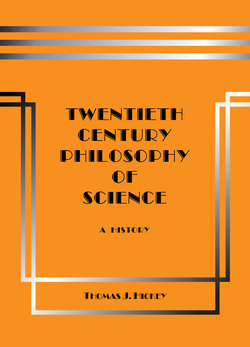Читать книгу Twentieth-Century Philosophy of Science: A History (Third Edition) - Thomas J. Hickey - Страница 28
На сайте Литреса книга снята с продажи.
Discovery:
ОглавлениеDiscovery is the construction of new and empirically more adequate theories.
Contemporary pragmatism is consistent with computerized discovery systems, which aim to proceduralize and mechanize new theory construction, in order to advance contemporary science.
In the “Introduction” to his magisterial Patterns of Discovery: An Inquiry into the Conceptual Foundations of Science (1958), Yale University philosopher of science Norwood Russell Hanson wrote that earlier philosophers of science like the positivists had mistakenly regarded as paradigms of inquiry finished systems like Newton’s planetary mechanics instead of the unsettled, dynamic research sciences like contemporary microphysics. Hanson explains that the finished systems are no longer research sciences, although they were at one time. And he states that distinctions applying to the finished systems ought to be suspect when transferred to research disciplines, and that such transferred distinctions afford an artificial account of the activities in which Kepler, Galileo and Newton were actually engaged. He thus maintains that ideas such as “theory”, “hypothesis”, “law”, “causality” and “principle” if drawn from what he calls the finished “catalogue-sciences” found in undergraduate textbooks will ill prepare one for understanding research-science.
Both romantics and positivists define “theory” semantically, while contemporary pragmatists define “theory” pragmatically, i.e., by its function in basic research.
Contemporary pragmatists define both theory and observation language pragmatically instead of semantically. The pragmatics of both types of language is empirical testing.
Theories are universally quantified statements that are proposed for testing.
Test-designs are universally quantified statements that are presumed for testing, to identify the subject of the test and to describe procedures for execution of the test, and they include universal statements that are semantical rules for the test-outcome statements that are asserted when the test outcome is produced and known.
The semantics of newly constructed theories reveal new perspectives and ontologies.
Scientific laws are former theories that have been tested with nonfalsifying test outcomes.
Observation language is particularly quantified test-design and test-outcome statements with their semantics defined in the universally quantified test-design language.
Unlike positivists, pragmatists do not recognize any natural observation semantics. For believers in a theory, the theory language may also contribute to the observational semantics, but that semantical contribution cannot operate in reporting the test outcome without violating the test’s contingency.
Contemporary pragmatists individuate theories semantically.
Two theory expressions are different theories either if the expressions have different test designs so they identify different subjects, or if the expressions make contrary claims about the same subject as defined by the same test design.
